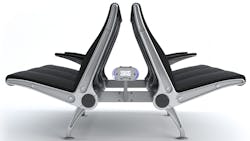As the number of passengers carrying multiple electronic devices grows, airports are offering more solutions to keep them charged. When it comes to electronic devices in airports, 82 percent of travelers use smartphones before boarding a flight, while 38 percent use laptops and 26 percent use tablets, according to a survey done by Swiss travel consultancy M1ndset.
Henry Harteveldt is a co-founder of the San Francisco-based Atmosphere Research Group travel consultancy and an expert on the passenger experience. “Power outlets have become a godsend because whether you’re a business or leisure traveler, you’re traveling with two to three electronic devices, including smartphones, laptops, tablets, eReaders and game devices,” he said. “We want to live our lives at 100 percent, especially on our smartphones, which are carried by 95 percent of U.S. passengers in airports.”
Having power outlets in airports is a great amenity, said Harteveldt. “And having them in seats is even better. It’s become the most important amenity aside from clean restrooms,” he stated.
For traveling families, parents can keep an eye on their kids and not worry about losing sight of them while they play or are on their devices, said Harteveldt. “It also means they don’t have to go to an expensive restaurant just to charge up.” For business travelers that don’t have access to airline lounges, they can still be productive while waiting for their flight, he added.
Travelers now take power outlets for granted,” said Harteveldt. “They don’t want to think and act like custodians to find outlets. They want the power brought to them,” he said. “And when you have enough electrical outlets, it reduces travel stress.”
Harteveldt has seen people get into fights over the use of outlets. “In Miami International Airport, I was traveling on Delta and the flight was delayed because of weather. There weren’t enough electrical outlets because the seats didn’t have outlets,” he recalled. “There were charging stations with power, but they were not conveniently located. People were hogging them and that was problematic for those who needed to charge their own devices, so fights broke out. It was bad enough that travelers were stuck there during a negative event. The power outlet fight only reinforced an already negative experience.”
Companies making seats with power options include Zoeftig, Arconas and Kusch+Co GmbH. All three companies offer solutions for existing and new seating in airport terminals.
Lynn Gordon is Arconas’ vice president for airport solutions. Her company’s first in-seat power model came out back in 2007.
“We did that installation at Boston Logan International, an airport that was an early adopter of in-seat power,” said Gordon. “The second version of the seats, which came out in late 2008, had regular and USB outlets,” she said. “Version three now also included two USB type C outlet. Instead of a rectangular plug, type C is a smaller oval-shaped one.”
The USB type C outlet is on newer smartphones and the MacBook Air, said Gordon. “Things are always evolving, where with seats, the technology never changes,” she said. Electronics change at a more rapid pace and you have to keep up.”
Lucia Kortscheff is the Kusch sales manager covering Spain, Portugal, Latin America and the United States. Her company was first contacted about in-seat power at airports in 2008.
“At the time we did not have a solution, so we decided to study different possibilities with electrical suppliers. When the iPhone 4 was launched in 2010 and smartphones were sold in huge quantities, the airports needed to react and provide their passengers with more charging facilities,” said Kortscheff. “Our first project where we included electrification outlets in our bench system was Vienna Airport in Austria in 2011. At the time, we designed a nice looking horizontal four-plug powerbox manufactured by Bachmann.”
Since then, Kusch has installed its products in airports all around the world with completely different solutions, said Kortscheff. The company manufactures five product lines for the transportation industry that includes different power and USB ports solutions as options. “All our tables also have the possibility to add different electrical outlets.”
Arconas has many products, with both retrofitted and integrated power in seats, said Gordon. “We also now have power bars installed on moveable modular counters, which are very popular right now. They’re popular with millennials because they tend to be less space-conscious about who’s sitting next to them.” she said. “It also works for business travelers who need a place to perch while they wait for their flights. Any of our seating products can be retrofitted with power because that’s what people are looking for. The sky’s the limit.”
Existing terminals and infrastructure designed years ago are very hard to retrofit, said Kortscheff. “Airport concourses designed years ago were never known for their abundance of electrical sockets. In an existing structure, tearing out floors and walls to add sockets can cost thousands per outlet, versus around $200 for an outlet in a renovated or new terminal,” she said. “Therefore, we work very close with the airports and their designers in order to accommodate as many power and USB outlets as possible in our benches, all connected to just one socket. We also advise them on creating new public seating areas, such as tables with electrical outlets, informal seating islands with USB sockets and leisure or relaxing zones.”
Arconas has powered seating in more than 100 U.S. airports, including major hubs and smaller terminals, said Gordon. “We also do all the seating for American Airlines and just installed power seats in 15 of their airports across the country,” she said. “And Southwest Airlines is rolling out Aero seats that have power outlets attached to them.”
We’ve Got the Power
Wichita Dwight D. Eisenhower National Airport opened a new 12-gate terminal on June 3, 2015. As part of the construction program, the airport installed about 1,500 seats, with a ratio of 1.2 seats having an outlet, said Victor White, director of airports for the Wichita Airport Authority.
“However, because of the way we installed the power units, there are two USB ports and two regular outlets in each unit. Because we installed three power units for every 10 seats in a row, there are actually 12 total places to plug in for every 10 seats in a row,” said White.
While the new terminal was being designed, the airport conducted numerous surveys of passengers and focus groups in the community to find out what amenities they wanted to see, said White. “Overwhelmingly, lots of power outlets made the top of the list consistently.
“We conducted a big seating competition prior to deciding what make and model of chairs to purchase. We obtained sample seating from all of the airport chair manufacturers and set them up in our program management office,” White recalled. “We then brought in numerous folks to test out the chairs and let us know which ones were the most comfortable, which ones looked the best and which ones were the most durable.”
The airport brought in airline managers, airport board members, city councilmembers, airport staff, engineers, architects, consultants and even some outside parties from the community whenever they visited the airport for meetings and functions who had time to do the test, said White. “We purposely spilled coffee, soft drinks, milk and other liquids on the chairs to see which ones were easiest to clean and didn’t leave residue,” he said. “We selected the Arconas Flyaway chairs for the concourse gate seating, along with [their] in-Power flex units mounted underneath for the power outlets.”
In addition to the under-seat gate chairs, Wichita airport also installed both USB and regular power outlets at works stations located between every two gates, said White. “Each workstation has 10 USB and 10 regular outlets to serve seven barstools at the work counters,” he said. “We also picked the Arconas inPower stool for these areas as the best product using the same methodology as we did for the gate seats.”
Phoenix Sky Harbor International Airport first brought charging stations into its terminals in 2012, said spokeswoman Heather Lissner. “We added 240 electrical outlets and 204 USB ports throughout the airport,” she said. “Those include 36 new sets of padded chairs, each with a table in between with two outlets and one USB port.”
Sky Harbor also added 28 “Get Plugged In” charging stations. “Each charging station has six electrical outlets and six USB ports, with one side equipped for [disabled] customers,” said Lissner. “In 2013, we added an additional 36 sets of passed chairs with tables in between, each with two outlets and a USB port on top of the table. This added 72 outlets and 36 USB ports airport wide.”
The airport is currently in the process of modernizing Terminal 3, said Lissner. “Nearly every seat will have access to power when the project is complete, and we estimate that we will be adding about 3,000 outlets,” she said.
Travelers have frequently requested more access to power and charging stations for when they are on the go, said Lissner. “As America’s Friendliest Airport, we want to ensure that our customers have the best experience they can while traveling through our airport. We added these charging stations to meet our passenger needs, and are adding more as part of our Terminal 3 Modernization Program because we realize how important this is,” she said. “Having access to power along with our free WiFi gives our travelers the ability to stay connected while on the go.”
Philadelphia International Airport has 34 seats along the B/C Connector, which is lined with retail shops and a large food court, that have power/USB ports, said spokeswoman Diane Gerace. “These seats were installed by Xfinity in 2016 when it introduced its Xfinity on the Fly area across from the B/C food court,” she said.
American Airlines has about 150 power and USB ports in seats in its holding areas in Terminals A-West, A-East, B and C, said Gerace. “Southwest Airlines has cushioned seats in its gate areas that have consoles with power and USB ports, but they are not built into the seats. There are 86 of these ports,” she said. “Delta and JetBlue have charging stations in their gate areas, but they are not built into the seats.”
The airport is always striving to provide services and amenities to enhance the customer experience, said Gerace. “Convenient access to power charging stations is a growing demand and a service that customers expect,” she said. “Providing comfortable seats with power/USB ports brings this important amenity up a notch. Also, the power/USB ports in the seats in the holding areas are an added convenience for passengers who can charge their devices while waiting for their flights right in the gate areas. We are working on expanding this amenity even further in the airport.”
A Great Passenger Amenity
Arconas’ Gordon compared the need for power with the past demand for free WiFi. “Remember when WiFi came out and airports were charging for it? Passengers got angry about it, so airports started offering it for free,” she said. “Now people expect free WiFi in airports. And it’s almost like that with power now.”
Airports are also competing for high ratings in Airports Council International’s Airport Service Quality and the Skytrax awards, said Gordon. “Having power at gates is one of quickest and easiest ways to boost passenger ratings. The only thing worse than no power outlets is dirty restrooms,” she said.
Wichita’s White is convinced that adequate power to serve its customers is an absolute necessity in today’s connected traveler environment. “The customers overwhelmingly tell us that they are extremely pleased that we were able to offer as many convenient places to plug in,” he said.
With today’s technology, there is definitely an increase in demand for outlets, said Kusch’s Kortscheff. “We all carry phones, iPads and computers and our lifestyles are completely dependant of these devices.”
Batteries do not last longer than a day, said Gerace. “Anybody who has been desperate to charge a mobile at an airport understands the feeling of frustration and stress that can arise when you do not find any recharging station at the airport,” she said. “Manufacturers should help airports and airlines to provide this important feature in as many seats as possible in the most efficient way, no matter if it is an old terminal or new concourse.”
Today, just about everyone is traveling with portable devices that need to be charged, said Gerace. “Passengers expect to have easy access to charging stations wherever they are,” she said. “Adding the in-seat power capability enhances this amenity and makes it more convenient.”
Free power outlets are now part of the airport passenger experience, said Lissner. “We frequently hear from travelers that they need to stay connected while they are on the go. Whether this is a business traveler or a leisure traveler, our goal is to ensure that we are meeting their needs and delivering world-class customer service,” she said. “Having ample access to charging stations and power outlets is one way that we can continue to elevate the passenger experience while at Sky Harbor.”




